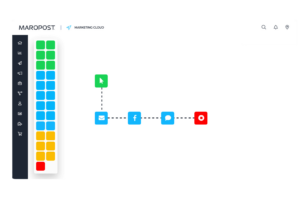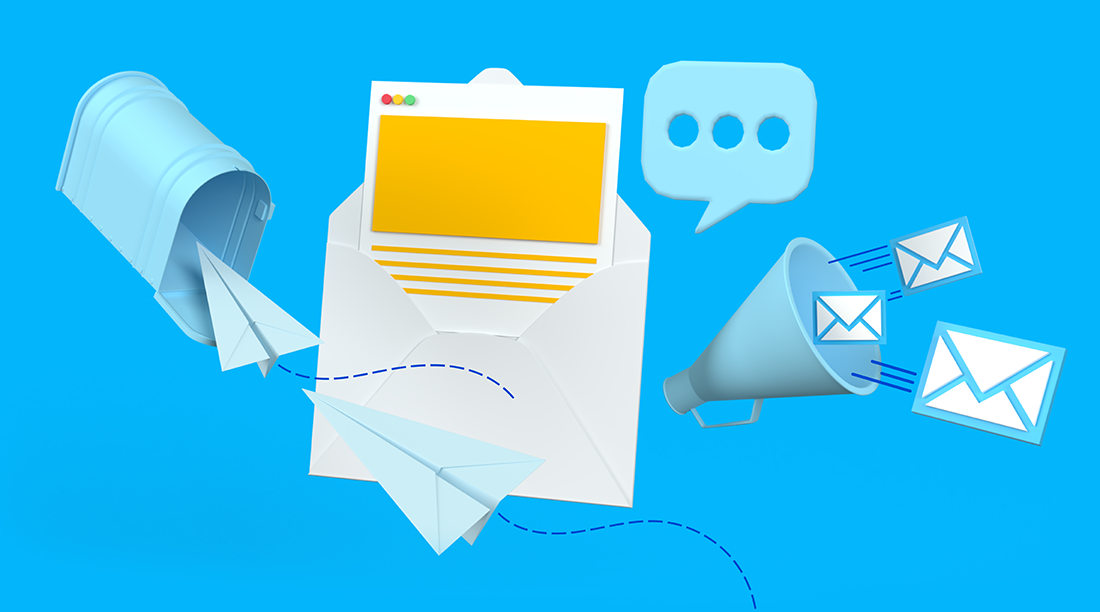There’s a ton of information out there about email marketing best practices. But it can feel overwhelming when you’re building an ecommerce email marketing strategy and you’re not sure where to start.
With several different types of ecommerce email marketing campaigns, how do you choose the right one for your business’s objectives? Understanding them is the first step toward building an effective strategy. Each email campaign type helps you achieve a specific goal, and you have to plan strategically to get the outcome you want.
Here are seven types of email campaigns ecommerce brands should be implement to increase customer loyalty and engagement and boost sales.
- The welcome email marketing campaign
- The promotional email marketing campaign
- The seasonal email campaign
- The automated email sequence
- The email newsletter
- The abandoned cart email campaign
- The re-engagement email campaign
1) Build trust with a welcome email marketing campaign
Your first post-purchase interaction with a new customer sets the tone for the entire relationship. A welcome email series is an opportunity to introduce your brand to customers and guide them through your offerings.
By sending new customers a series of three to five emails, you can tailor your messaging and progressively build trust. Even though these customers are new, you can still send further personalized welcome campaigns based on their purchasing behaviors.
Using personalized content to engage your customers early on sets the foundation for long-term retention.
Three ideas for integrating personalized content into your welcome email marketing campaign
- Custom product recommendations or links to relevant content on your site
- An invitation to sign up for your loyalty or rewards program
- A individual discount code to use on future purchases
Welcome emails receive higher than average open rates and click-throughs, meaning a high potential to gain more revenue. Even if you don’t implement any other email marketing campaigns, make sure you send a welcome series.
2) Drive revenue with promotional email marketing campaigns
You could spend a ton of time planning a great promotion or sale, but it won’t succeed if your email marketing campaign falls flat. Just like the promotion itself, a well-planned promotional email marketing campaign should be creative, cohesive, and purposeful.
The key is to develop a series of emails, strategically linking them together. Each email should build on the previous one, guiding the customer through a journey. Maybe the first introduces new products, the second highlights seasonal promotions, and the third offers an exclusive discount.
And remember that personalizing and customizing your customers’ journeys will always create more engagement (and it’s even easier now with AI tools). Thoughtful sequencing and consistent messaging create momentum, keeping your customers interested and more likely to click and convert.
Four key elements to keep in mind when crafting your promotional email campaign
- Present a clear and compelling offer. Your customers should know right away what’s in it for them and why they shouldn’t miss out.
- Create a sense of urgency. Encourage quick action by adding countdown timers, reminders about limited stock, or deadlines for the offer. A little urgency goes a long way in driving conversions.
- Add appealing visuals: Spotlight your brand identity to help showcase your products and create a more engaging experience.
- Include a strong call to action (CTA). Make sure every email has a clear and direct CTA. It should guide your customers to take the next step, like going to a product page or adding something to their wishlist.
3) Capture peak buying periods with seasonal email campaigns
Seasonal email campaigns offer a powerful opportunity to connect with your customers, driving both engagement and sales. Gift-giving holidays like Christmas, Hanukkah, Kwanzaa, and Diwali and seasonal events like Back-to-School, Mother’s Day, Father’s Day, Valentine’s Day, and Black Friday and Cyber Monday create natural opportunities for ecommerce brands to build excitement.
By planning early, you can also build anticipation, offering sneak peeks, exclusive previews, or countdowns to major sales events. This helps generate excitement, keeps your brand top of mind, and encourages customers to keep checking in, maximizing engagement and conversions.
Consider these three strategies to make your seasonal campaigns successful
- Tailor to the holiday. Understand the holidays and events that matter most to your audience, especially if you operate across different regions. Personalize your content to reflect the culture and preferences of each market.
- Start early. Holiday seasons are competitive, with countless brands vying for attention. Get ahead by starting your campaign early, ensuring your message is one of the first in your customers’ inboxes.
- Offer exclusive incentives. Holiday-specific promotions like exclusive discounts or limited-time offers can be powerful motivators. Try to create a sense of exclusivity that encourages customers to take action.
By thoughtfully planning your seasonal email campaigns, you can not only capture your customers’ attention but also turn the holiday period into a revenue driver.
4) Follow customer behavior with automated email sequences
With automated email sequences, you can have a user’s action trigger a series of targeted and relevant emails.
Maybe they clicked a link in one of your promotional emails, or they abandoned their cart after browsing your site. Or perhaps they engaged with your brand in another way by leaving a review or reading certain content on your site. All these actions can be triggers to initiate an email campaign tailored to their behavior and preferences.
Email open rates double with triggered campaigns compared to campaigns that aren’t tied to specific customer actions.
An example of a post-purchase triggered email campaign
- Thank you email (sent immediately after purchase). Thank the customer for their purchase and include a well-designed summary of their order.
- Shipping notification and inspo (sent when order ships). Send a shipping notification that clearly shows the expected delivery date. Use this opportunity to get the customer excited about their product by embedding social media posts about their product.
- Delivery notification and care tips (sent when the order is delivered). When you send an email to let them know their product has arrived, include anything they need to know to care for it. Make it clear how they can get help if they need it from your support team.
- Review request (sent one week after delivery). Send an email asking how they like their product with a clear way to reach out for support if needed. Ask for a review in exchange for some incentive like a discount code or points in your loyalty program.
Maropost can help you build personalized automated email journeys with an intuitive drag-and-drop tool. To learn how, click here.

5) Gain loyal subscribers with the email newsletter
A well-crafted newsletter is one of the best ways to build and maintain customer relationships. For ecommerce brands, newsletters can offer more than just promotions. They are an opportunity to provide value through regular updates, tips, and insights that customers want.
A strong newsletter prioritizes educating, entertaining, or inspiring your audience. Whether it’s offering tips, seasonal advice, or a peek behind the scenes, the goal is to make each email feel relevant and helpful. This builds a relationship over time, rather than just pushing sales.
Consistency is key. By showing up regularly with useful content, your brand will stay top of mind without being intrusive. Newsletters can boost loyalty and turn casual shoppers into repeat customers, and they can even grow your audience as subscribers share content with others. In short, newsletters keep your brand connected to customers by offering value beyond the sale.
Three examples of ways certain types of ecommerce brands could achieve this with a newsletter
- If you’re in the wellness industry, address the motivations driving customers to buy your products. Share practical tips and content tailored to each customer focused on their specific health and wellness needs.
- If you’re a fashion brand with sustainability is your focus, share impactful stories. Highlight meaningful progress, both within your company and in the broader industry. Educate your audience on how their choices contribute to a sustainable future, and inspire them to stay engaged in the movement.
- If you sell specialty foods, inspire readers with creative recipes. Offer simple-to-make recipes that incorporate your products. Show customers how your ingredients can bring excitement to their meals and introduce them to new culinary experiences.
6) Re-capture potential customers with the abandoned cart email campaign
Abandoned cart emails are one of the most effective types of automated email campaigns for ecommerce brands. When a customer adds an item to their cart but doesn’t complete the purchase, it doesn’t have to be the end of the road. Regardless of why they left, nudging them with an incentive may be enough to encourage them to complete their order.
Abandoned cart email campaigns tap into a customer’s existing interest and intent, making them more likely to convert. In fact, abandoned cart emails typically see higher open rates and conversion rates compared to other types of campaigns. Setting up abandoned cart emails is within reach for even growing brands, and the benefits are well worth the effort.
Three ways to implement abandoned cart emails effectively
- Showcase social proof. Include customer reviews or testimonials related to the abandoned products. By building confidence, you may entice the shopper to complete their purchase.
- Offer a discount. If price was the reason the customer was on the fence, even a small 10% discount might be enough to get them to purchase.
- Offer alternative products: Suggest complementary or alternative items based on what the customer left in their cart. This can help if the original product didn’t meet all their needs.
9) Win customers back with the re-engagement email campaign
Every ecommerce brand loses email subscribers. In fact, it’s common to see about 25-30% of your email list churn each year. Even still, you can re-engage subscribers who have gone silent.
A re-engagement email campaign is designed to reconnect with subscribers who haven’t opened your emails in at least six months or so. You may either bring them back as active subscribers, or you may remove them from your list. By doing this, you can keep your email list healthy and maintain your brand’s reputation.
A re-engagement campaign is about giving your inactive subscribers another chance to reconnect, not cutting them loose. Maybe they’ve lost interest, or maybe they simply haven’t seen your emails lately. Either way, this campaign is your opportunity to remind them of the value you bring.
Three ideas for running an effective re-engagement campaign
- Remind them of what they’re missing. Remind subscribers of the benefits they’re missing out on, whether it’s exclusive discounts or product updates.
- Offer a special incentive. A limited-time offer, like a discount or free shipping, can encourage subscribers to re-engage. Position it as a ‘welcome back’ gesture rather than just another promotion.
- Give them an easy way out: Be transparent and give your subscribers the option to easily unsubscribe. It’s better to have a smaller, engaged list than a large one full of inactive users.
By running regular re-engagement campaigns, you can keep your email list fresh, protect your deliverability, and ensure your emails are reaching people who truly want to hear from you.
Maropost Marketing Cloud allows growing ecommerce brands to easily build highly customized, AI-powered customer journeys so you get more out of your email marketing efforts. To learn more about how Maropost can help you get higher deliverability and conversions from your email marketing campaigns, get a demo.
Need to chat about your mobile marketing strategy?
More than 10,000 marketers use Maropost to engage with their prospects and customers through emails, SMS, social media and more. We’re here to help you growing your business!
Chat Now

